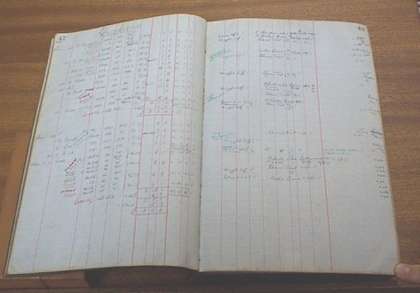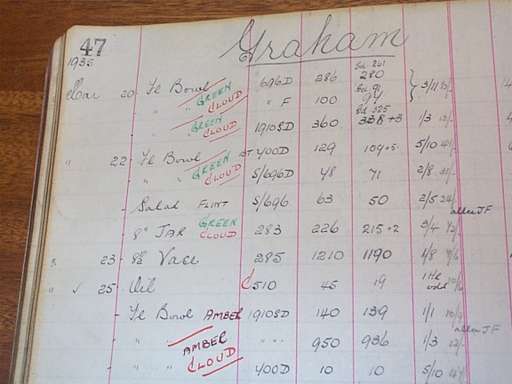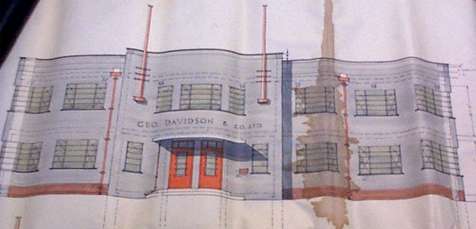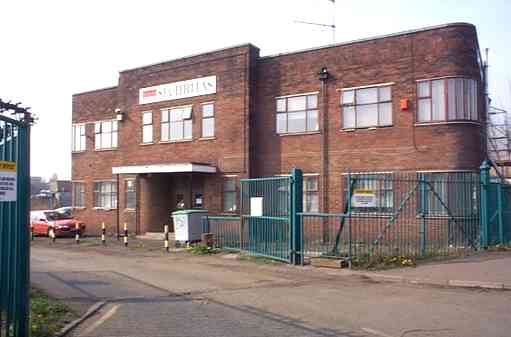|
|
||||||||||||||||||||||
|
||||||||||||||||||||||
Introduction
Welcome to the August Cloud Glass newsletter from a rather wet Great Britain. We have been delving into the Archives once again and in this newsletter we bring you the following:
- Davidson's Glassmakers records - what is available
- Davidson's 1939 offices - then and now
- The Alexandra Electric Light Company - another George Davidson venture ?
- More reports from the Pottery Gazette
Once we have completed processing the data obtained from our recent visits to the Newcastle Archives, we will be adding the following to the web site :
- Complete catalogue of Green Cloud Glass (except for 1941 when very little was made)
- Complete catalogue of all Cloud Glass produced between 1932 and 1943 (except for 1941)
- More detail about when some designs were first and last produced.
- Information about wholesale prices for Cloud Glass between 1932 and 1943.
Cloud Glass Web site
Since the last newsletter, we have completed the list of Davidson registered designs and the Davidson posy bowl page. The registered designs pages now have the first complete list of all Davidson registered designs.
Davidson's Glassmakers Records
There are, unfortunately, few surviving records of the Davidson Company. Most if not all of what exists can be found in the Tyne-and-Wear Archives in Newcastle-upon-Tyne. The main bulk of these records consist of 'Account' books for the years 1932 to 1944. These account books are in fact the records of what each of the glassmakers made at the works. From these we were able to create the inventory of Orange Cloud Glass that was first published on this site a few months ago. Each account book covered a period of approximately one year and contained 400 double page entries.
Where these records originated is unknown. Their condition shows that they had been in a fire and subsequently water damaged. In fact the Chief Archivist had to unstick some of pages in the volumes before we were able to look at them! They are a mine of information about glass production in the 1930s. The picture below (By permission of the Chief Archivist, Tyne and Wear Archives) shows a typical page from the account books (Sadly the condition of the records is such that they cannot be photocopied).

 This
Picture, right, is a close up of the top of the left hand page in the image
above. At the very top of the page is the name of the glassmaker, in this case
Mr. Graham whose Christian name we do not know. The first column contains the
date. The second and third column contains the type of glass e.g. Flower Bowl,
Jar, Vase etc. and the pattern number. The type and colour of glass that the
article was made in is indicated by
the green and red writing in column two. Thus we can see that on March 20 1935,
Graham made 696D, 696F and 1910SD flower bowls in Green Cloud Glass. On
subsequent days he made articles in flint, Amber, Amber Cloud and Green Cloud
Glass. From our research we know that Graham was an experienced glassmaker and
one the the few who made large quantities of Cloud Glass.
This
Picture, right, is a close up of the top of the left hand page in the image
above. At the very top of the page is the name of the glassmaker, in this case
Mr. Graham whose Christian name we do not know. The first column contains the
date. The second and third column contains the type of glass e.g. Flower Bowl,
Jar, Vase etc. and the pattern number. The type and colour of glass that the
article was made in is indicated by
the green and red writing in column two. Thus we can see that on March 20 1935,
Graham made 696D, 696F and 1910SD flower bowls in Green Cloud Glass. On
subsequent days he made articles in flint, Amber, Amber Cloud and Green Cloud
Glass. From our research we know that Graham was an experienced glassmaker and
one the the few who made large quantities of Cloud Glass.
The next two columns indicate the number of items made and the number that passed inspection i.e. for which the glassmaker was paid the full rate. The later figure is sometimes amended e.g. on the 22 March he made 129 700D flower bowls, of which 109+5 were passed. This indicates that initially 109 passed inspection, but another 5 were later allowed. On the right hand side of the book are often written comments explaining why there were so many failures, or why the number passed had been increased. Sometimes Thomas Davidson himself would inspect the glass, and in most cases he would increase the number well above what was originally passed.
The sixth column contains a figure relating to the amount of money the glass maker was paid for this work and, in pencil, the wholesale price of the glass (per dozen). A high failure rate was not necessarily the glassmaker's fault. For example there may be problems with the mould or the batch of glass. In these cases the an hourly rate was paid, depending on how much time was spent on making the particular shape. Cloud Glass was particularly difficult to make and the failure rate was higher than for ordinary flint and coloured glass.
The full list of Davidson records held by the Tyne-and Wear archives is as follows:
| Accession Number | Description |
| 675/1 | Minute book, 1934-1949. In 1934 Davidson & Co. became a limited company and was required by law to have regular shareholder meetings and record the minutes. Some of the information on the History page is taken from this minute book. |
| 675/2 | Letter Book 1923. This contains copies of personal letters written by Claude Fraser. We will be including some extracts from these in a future newsletter. |
| 675/3 | Day Book 1876 to 1880. This documents Davidson's income
for these years. The totals for each year are (in pounds, shillings and
pence):
|
| 675/4 | Account Book 1886. This contains an inventory of glass stock held in December 1886 (total of £2,195-6-81/2) |
| 675/6 to 675/16 | Purchase journals for 1935 to 1950. These record all of the company's outgoings. |
| 675/17 | Memorandum & Articles of association of G Davidson & Co Ltd, 1934. This is the legal agreement drawn up when Geo Davidson became a limited company. It is a requirement of company law. |
| 675/18 | Catalogue of Holophane glass products |
| 681/1 | Account Book (Glassmakers records) 1920 to 1921 |
| 681/2 | Account Book (Glassmakers records) 1921 to 1922 |
| 681/3 to 681/11 | Account Book (Glassmakers records) 1932 to 1940 |
| 681/12 | Account Book (Glassmakers records) 1942 to 1943 |
| 681/13 | Account Book (Glassmakers records) 1943 to 1944 |
Davidson's 1939 Offices - then and now
In 1939 plans were approved for some new offices for the Teams Glassworks - despite the fact that money need to be spent on the existing factory (see here). The offices were to be located at the entrance to the site and be built in the Art Deco style. The pictures below show the front elevation of the offices and a close-up view of the entrance.


(By permission of the Chief Archivist, Tyne and Wear Archives,
Acc No T311/1939/261)
This two storey building was designed with many classic Art Deco features. Of particular note are the wide metal framed windows and the interior hallways which were designed to have terrazzo floors. Flanking the first floor showroom, which was located above the entrance hall, are two flag poles. The inside accommodation consisted of:
Basement:
Strong room/ARP Shelter
Ground Floor:
General Office
Mr Gellow's office (which had a glass partition to the typists room)
Mr Balman's office
Typists room
Room for Drawings and Instruments
Directors' Cloakroom
First Floor:
Director's (Mr Frazer) office with Oak Parquet flooring
Mrs Robb's office
Showroom
Mr Fullerton's office
Office for Typists
Store room
Cloakroom (Men and Woman)
Even in 1939, when the plans were approved, there was concern about enemy action as the strong room doubled as an ARP shelter.
Although the Davidson factory has gone, these offices still remain and are being used today by a security firm.

The Alexandra Electric Light Company - Another George Davidson Venture?
In the 19th Century George Davidson was a well respected man both in business and in local government. He was a Justice of the Peace, a councillor for over 30 years, Mayor of Gateshead for two years, Chairman of the local board of the Federal Fire Insurance Company, a member of the local directorate of the Northern Accident Insurance Company, Chairman of the Newcastle Builders Insurance Company and also served on the Tax Commission. To quote 'Tyneside Industries' of 1889 he was also 'proprietor of several other works of considerable importance among modern Tyneside Industries' .
In 1884 one of his ventures may have been the Alexandra Electric Light Company of Gateshead. During 1884 and 1885 'George Davidson, Robert Cattley Jackson and John Black Duncan of the Alexandra Electric Light Company' submitted no fewer than 6 patent applications and one registered design all related to the manufacture of incandescent electric light bulbs. The patents were:
14552/84 "Improvements in mercurial air or vacuum pumps" 14553/84 "Improvements in the manufacture of carbon for incandescent electric lamps and apparatus to be used therein" 15754/84 "Improvements in incandescent electric lamps" 15764/84 "Improved means to be employed in the production of the vacuum in the bulbs of incandescent electric lamps" 3765/85 "Improvements in the manufacture of filaments and carbon for incandescent electric lamps" 3769/85 "Improvements in the manufacture of filaments for incandescent electric lamps"
Of these only 3765/85 was accepted. The company registered one design, number 16562, Class I in November 1884.
Tyneside was in the forefront of the development of incandescent electric lights. In 1878 Sir Joseph Swan demonstrated the first practical incandescent carbon filament lamp in Newcastle. Two years later Sir Joseph's house in Gateshead was the first house in the UK to be lit by incandescent lamps. It would make sense for George Davidson to combine his experience of the glass industry with the new electric lamp technology.
To date we have been unable to find out anymore about the Alexandra Electric Company. We cannot confirm for certain that the George Davidson who co-authored the patents is the same man who founded Davidson glass. Our research continues.
Reports from the Pottery Gazette
In the last newsletter we described the advert for Davidson's exhibition at the 'North East Coast Exhibition of Industry, Science and Art'. In June 1929 the Pottery Gazette reported on the event and had the following to say about Geo Davidson:
George Davidson & Co., of the teams Glass Works, Gateshead, have erected their stand to represent a Norman Castle, which is effectively decorated both inside and outside. Main features of the exhibit are the firm's display of coloured glassware in purple, blue and amber with cloud effects. There is also on show a choice collection of flower bowls, vases, candlesticks and trinket sets. In fact, there is a complete range of the well-known products of this Tyneside firm, consisting of table and decorative glassware made by moulding and pressing. One of the many attractions at the stand is a pyramid made up of flower blocks, illuminated by varied coloured electric lights, giving a pleasing effect'
At the 1939 British Industries Fair, Davidson launched their new 'Ripple' pattern. The Pottery Gazette reported as follows:
'Geo. Davidson & Co., Ltd., Teams Flint Glass Works, Gateshead-on-Tyne. - Some excellent new productions were offered by this firm in both domestic and fancy pressed glass. We noticed on view a number of new shapes incorporating a wavy design. These, we learned, are the work of Mr J. G. Fullerton, the firm's own designer. A new smoke coloured glass was prominently displayed, Very interesting, too, was a new modernly designed seven-piece trinket set with candlesticks and scent spray. There was also a new globe-shaped lamp, made in two sizes and finished off with a chromium band. This was said to be available in all colours. A new line which seemed to gain immediate interest was a fan-shaped vase, modelled in such a way that it can serve either as a table centre or a stand upon a narrow mantelshelf. An excellent display of flowers can be arranged in this new vase with but little trouble. Several of these vases, one of emerald green colouring, were purchased by Queen Mary. The Princess Royal purchased some of the new smoke-coloured vases as well as a number of useful table articles. Once again the Davidson stand was most artistically arranged, advantage being taken of the flower vases to demonstrate how true they can be to their purpose.'
The 'Wavy' design is the well know 'Ripple' pattern. The trinket set referred to was the 360 set (see our trinket set page).
Cloud Glass on Ebay
We will be updating the Ebay Statistics page shortly with data from November 2001 to August 2002
|
|
|
|